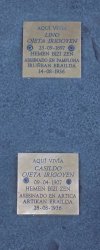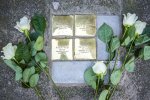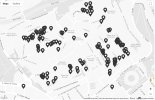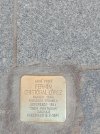A Stolperstein is a ten-centimetre (3.9 in) concrete cube bearing a brass plate inscribed with the name and life dates of victims of Nazi extermination or persecution. Literally, it means 'stumbling stone' and metaphorically 'stumbling block'. The Stolpersteine project was initiated by the German artist Gunter Demnig in 1992. [Wikipedia]
In Pamplona I came across two similar plates at 63 Calle de la Estafeta. The plates were not brass, however, but probably stainless steel. They commemorated Lino Ojeta Irigoyen, shot in Pamplona 14-08-1936, aged 38, and Casildo Ojeta Irigoyen, murdered in Artica 28-08-1936, aged 29.
These people were obviously murdered during the Spanish Civil War, and therefore not victims of Nazi extermination. I cannot think of a better place to ask than here on the Camino Forum. My questions are: What are these plates (presumably attached to a 10-cm concrete cube) called in Spanish? When did the project to commemorate victims of the Spanish Civil War begin? Who initiated the project? How many plates have been placed so far? How many more are there to be?
If you don't know the answers, but know of a better possible source for the answers, please let me know.

In Pamplona I came across two similar plates at 63 Calle de la Estafeta. The plates were not brass, however, but probably stainless steel. They commemorated Lino Ojeta Irigoyen, shot in Pamplona 14-08-1936, aged 38, and Casildo Ojeta Irigoyen, murdered in Artica 28-08-1936, aged 29.
These people were obviously murdered during the Spanish Civil War, and therefore not victims of Nazi extermination. I cannot think of a better place to ask than here on the Camino Forum. My questions are: What are these plates (presumably attached to a 10-cm concrete cube) called in Spanish? When did the project to commemorate victims of the Spanish Civil War begin? Who initiated the project? How many plates have been placed so far? How many more are there to be?
If you don't know the answers, but know of a better possible source for the answers, please let me know.






















